Giovanni Geraci
Cellular Network Design for UAV Corridors via Data-driven High-dimensional Bayesian Optimization
Apr 07, 2025Abstract:We address the challenge of designing cellular networks for uncrewed aerial vehicles (UAVs) corridors through a novel data-driven approach. We assess multiple state-of-the-art high-dimensional Bayesian optimization (HD-BO) techniques to jointly optimize the cell antenna tilts and half-power beamwidth (HPBW). We find that some of these approaches achieve over 20dB gains in median SINR along UAV corridors, with negligible degradation to ground user performance. Furthermore, we explore the HD-BO's capabilities in terms of model generalization via transfer learning, where data from a previously observed scenario source is leveraged to predict the optimal solution for a new scenario target. We provide examples of scenarios where such transfer learning is successful and others where it fails. Moreover, we demonstrate that HD-BO enables multi-objective optimization, identifying optimal design trade-offs between data rates on the ground versus UAV coverage reliability. We observe that aiming to provide UAV coverage across the entire sky can lower the rates for ground users compared to setups specifically optimized for UAV corridors. Finally, we validate our approach through a case study in a real-world cellular network, where HD-BO identifies optimal and non-obvious antenna configurations that result in more than double the rates along 3D UAV corridors with negligible ground performance loss.
Optimizing UAV Aerial Base Station Flights Using DRL-based Proximal Policy Optimization
Apr 04, 2025Abstract:Unmanned aerial vehicle (UAV)-based base stations offer a promising solution in emergencies where the rapid deployment of cutting-edge networks is crucial for maximizing life-saving potential. Optimizing the strategic positioning of these UAVs is essential for enhancing communication efficiency. This paper introduces an automated reinforcement learning approach that enables UAVs to dynamically interact with their environment and determine optimal configurations. By leveraging the radio signal sensing capabilities of communication networks, our method provides a more realistic perspective, utilizing state-of-the-art algorithm -- proximal policy optimization -- to learn and generalize positioning strategies across diverse user equipment (UE) movement patterns. We evaluate our approach across various UE mobility scenarios, including static, random, linear, circular, and mixed hotspot movements. The numerical results demonstrate the algorithm's adaptability and effectiveness in maintaining comprehensive coverage across all movement patterns.
Large-Scale AI in Telecom: Charting the Roadmap for Innovation, Scalability, and Enhanced Digital Experiences
Mar 06, 2025Abstract:This white paper discusses the role of large-scale AI in the telecommunications industry, with a specific focus on the potential of generative AI to revolutionize network functions and user experiences, especially in the context of 6G systems. It highlights the development and deployment of Large Telecom Models (LTMs), which are tailored AI models designed to address the complex challenges faced by modern telecom networks. The paper covers a wide range of topics, from the architecture and deployment strategies of LTMs to their applications in network management, resource allocation, and optimization. It also explores the regulatory, ethical, and standardization considerations for LTMs, offering insights into their future integration into telecom infrastructure. The goal is to provide a comprehensive roadmap for the adoption of LTMs to enhance scalability, performance, and user-centric innovation in telecom networks.
Mathematical Cell Deployment Optimization for Capacity and Coverage of Ground and UAV Users
Feb 02, 2025Abstract:We present a general mathematical framework for optimizing cell deployment and antenna configuration in wireless networks, inspired by quantization theory. Unlike traditional methods, our framework supports networks with deterministically located nodes, enabling modeling and optimization under controlled deployment scenarios. We demonstrate our framework through two applications: joint fine-tuning of antenna parameters across base stations (BSs) to optimize network coverage, capacity, and load balancing, and the strategic deployment of new BSs, including the optimization of their locations and antenna settings. These optimizations are conducted for a heterogeneous 3D user population, comprising ground users (GUEs) and uncrewed aerial vehicles (UAVs) along aerial corridors. Our case studies highlight the framework's versatility in optimizing performance metrics such as the coverage-capacity trade-off and capacity per region. Our results confirm that optimizing the placement and orientation of additional BSs consistently outperforms approaches focused solely on antenna adjustments, regardless of GUE distribution. Furthermore, joint optimization for both GUEs and UAVs significantly enhances UAV service without severely affecting GUE performance.
Capacity and Power Consumption of Multi-Layer 6G Networks Using the Upper Mid-Band
Nov 14, 2024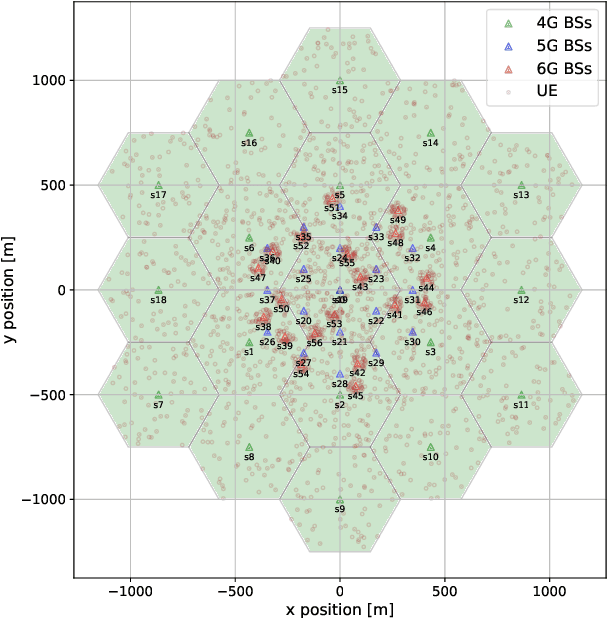
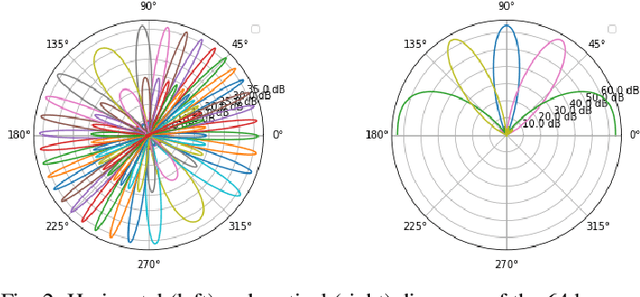
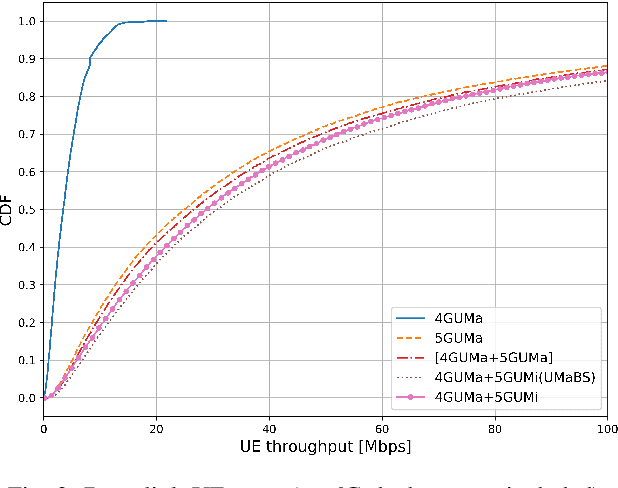
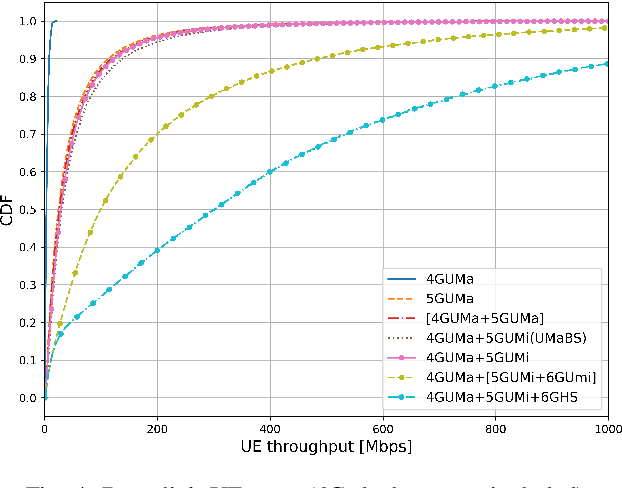
Abstract:This paper presents a new system model to evaluate the capacity and power consumption of multi-layer 6G networks utilising the upper mid-band (FR3). The model captures heterogeneous 4G, 5G, and 6G deployments, analyzing their performance under different deployment strategies. Our results show that strategic 6G deployments, non-co-located with existing 5G sites, significantly enhance throughput, with median and peak user rates of 300 Mbps and exceeding 1 Gbps, respectively. We also emphasize the importance of priority-based cell reselection and beam configuration to fully leverage 6G capabilities. While 6G implementation increases power consumption by 33%, non-colocated deployments strike a balance between performance and power consumption.
Physically Consistent RIS: From Reradiation Mode Optimization to Practical Realization
Sep 26, 2024Abstract:We propose a practical framework for designing a physically consistent reconfigurable intelligent surface (RIS) to overcome the inefficiency of the conventional phase gradient approach. For a section of Cape Town and across three different coverage enhancement scenarios, we optimize the amplitude of the RIS reradiation modes using Sionna ray tracing and a gradient-based learning technique. We then determine the required RIS surface/sheet impedance given the desired amplitudes for the reradiation modes, design the corresponding unitcells, and validate the performance through full-wave numerical simulations using CST Microwave Studio. We further validate our approach by fabricating a RIS using the parallel plate waveguide technique and conducting experimental measurements that align with our theoretical predictions.
TSpec-LLM: An Open-source Dataset for LLM Understanding of 3GPP Specifications
Jun 03, 2024



Abstract:Understanding telecom standards involves sorting through numerous technical documents, such as those produced by the 3rd Generation Partnership Project (3GPP), which is time-consuming and labor-intensive. While large language models (LLMs) can assist with the extensive 3GPP knowledge base, an inclusive dataset is crucial for their effective pre-training and fine-tuning. In this paper, we introduce \textit{TSpec-LLM}, an open-source comprehensive dataset covering all 3GPP documents from Release 8 to Release 19 (1999--2023). To evaluate its efficacy, we first select a representative sample of 3GPP documents, create corresponding technical questions, and assess the baseline performance of various LLMs. We then incorporate a retrieval-augmented generation (RAG) framework to enhance LLM capabilities by retrieving relevant context from the \textit{TSpec-LLM} dataset. Our evaluation shows that using a naive-RAG framework on \textit{TSpec-LLM} improves the accuracy of GPT-3.5, Gemini 1.0 Pro, and GPT-4 from 44\%, 46\%, and 51\% to 71\%, 75\%, and 72\%, respectively.
The Meta Distribution of the SIR in Joint Communication and Sensing Networks
Apr 02, 2024Abstract:In this paper, we introduce a novel mathematical framework for assessing the performance of joint communication and sensing (JCAS) in wireless networks, employing stochastic geometry as an analytical tool. We focus on deriving the meta distribution of the signal-to-interference ratio (SIR) for JCAS networks. This approach enables a fine-grained quantification of individual user or radar performance intrinsic to these networks. Our work involves the modeling of JCAS networks and the derivation of mathematical expressions for the JCAS SIR meta distribution. Through simulations, we validate both our theoretical analysis and illustrate how the JCAS SIR meta distribution varies with the network deployment density.
Spatially Consistent Air-to-Ground Channel Modeling via Generative Neural Networks
Feb 05, 2024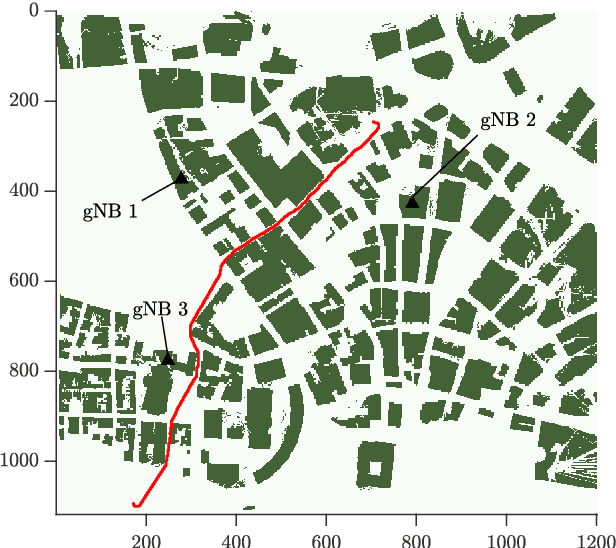
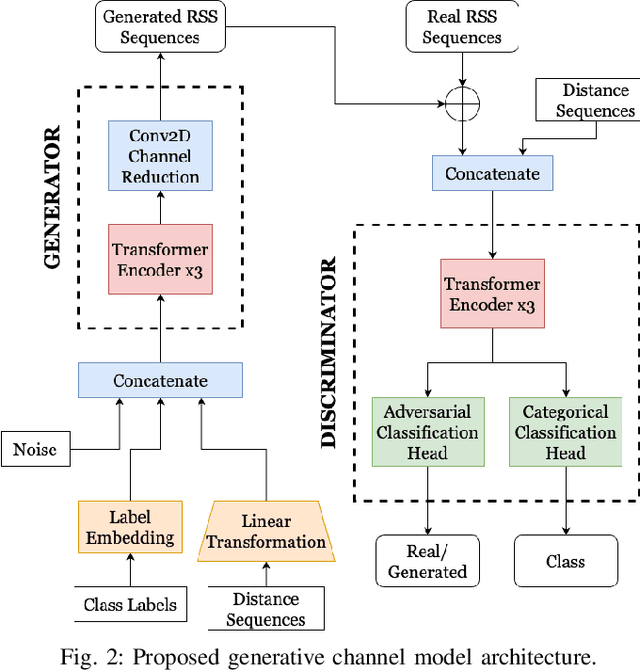
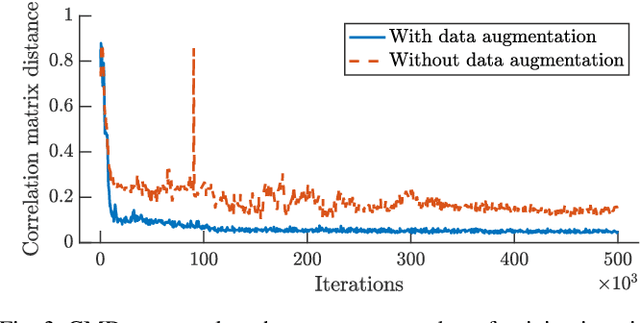

Abstract:This article proposes a generative neural network architecture for spatially consistent air-to-ground channel modeling. The approach considers the trajectories of uncrewed aerial vehicles along typical urban paths, capturing spatial dependencies within received signal strength (RSS) sequences from multiple cellular base stations (gNBs). Through the incorporation of conditioning data, the model accurately discriminates between gNBs and drives the correlation matrix distance between real and generated sequences to minimal values. This enables evaluating performance and mobility management metrics with spatially (and by extension temporally) consistent RSS values, rather than independent snapshots. For some tasks underpinned by these metrics, say handovers, consistency is essential.
Throughput Analysis of IEEE 802.11bn Coordinated Spatial Reuse
Sep 17, 2023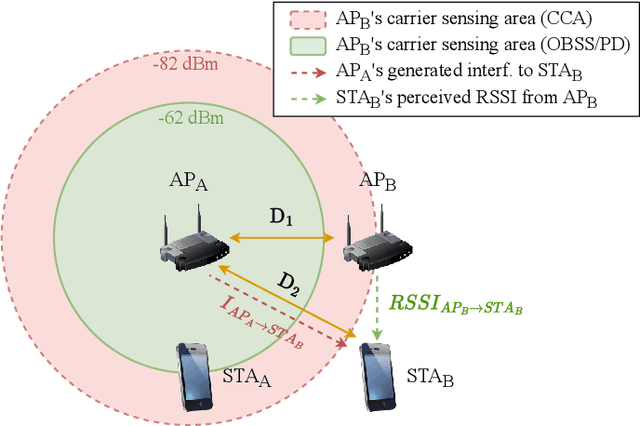
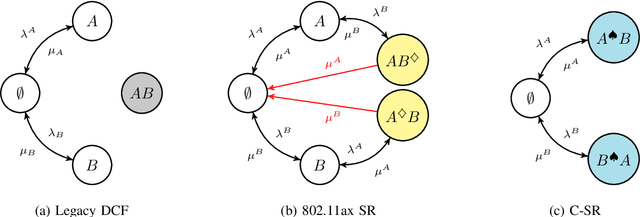
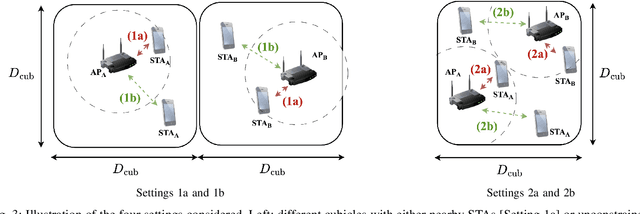

Abstract:Multi-Access Point Coordination (MAPC) is becoming the cornerstone of the IEEE 802.11bn amendment, alias Wi-Fi 8. Among the MAPC features, Coordinated Spatial Reuse (C-SR) stands as one of the most appealing due to its capability to orchestrate simultaneous access point transmissions at a low implementation complexity. In this paper, we contribute to the understanding of C-SR by introducing an analytical model based on Continuous Time Markov Chains (CTMCs) to characterize its throughput and spatial efficiency. Applying the proposed model to several network topologies, we show that C-SR opportunistically enables parallel high-quality transmissions and yields an average throughput gain of up to 59% in comparison to the legacy 802.11 Distributed Coordination Function (DCF) and up to 42% when compared to the 802.11ax Overlapping Basic Service Set Packet Detect (OBSS/PD) mechanism.
 Add to Chrome
Add to Chrome Add to Firefox
Add to Firefox Add to Edge
Add to Edge